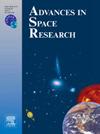大孔径空间望远镜在轨组装机器人技术:综述
IF 2.8
3区 地球科学
Q2 ASTRONOMY & ASTROPHYSICS
引用次数: 0
摘要
从标志性的哈勃太空望远镜到钱德拉和开普勒等专用仪器,太空望远镜在启迪我们对宇宙的认识方面发挥了重要作用。太空探索的未来取决于模块化大孔径太空望远镜(LAST),它比最近发射的 6.5 米詹姆斯-韦伯太空望远镜大得多,需要在轨道上用机器人组装。本文以机器人在轨组装大口径太空望远镜为特色,介绍了天文观测模式的转变。这篇综述论文首先追溯了望远镜的发展历程,并全面概述了最先进的空间望远镜。然后,本文强调了 LAST 的必要性,以满足人们对更高分辨率天文学的不断需求。虽然目前的半自主机器人操纵器在国际空间站上运行,但其有限的行走能力限制了其工作空间,使其不适合 LAST 任务。本文对使用候选机器人进行 LAST 在轨组装所面临的挑战进行了详细的权衡分析,以了解技术差距。此外,本文还介绍了空间机器人机械手的演变,突出了在轨航天器维修和组装任务的设计特点、优势和缺点。为了应对空间机器人系统在极端空间环境中的各种扰动所带来的设计和建模挑战,还讨论了实现超高精度性能所需的线性和非线性控制系统。本文介绍了下一代太空行走机械手--端对端行走机械手(E-Walker),从而推动了太空行走机械手技术的发展。E-Walker 的灵巧性和模块化设计使其成为涉及装配、制造、维修和维护任务的理想候选者。本文章由计算机程序翻译,如有差异,请以英文原文为准。
Robotic technologies for in-orbit assembly of a large aperture space telescope: A review
Space telescopes have been instrumental in enlightening our understanding of the universe, from the iconic Hubble Space Telescope to specialized instruments like Chandra and Kepler. Pushing the frontiers of cosmic exploration, the future of space exploration hinges on modular Large Aperture Space Telescopes (LAST), much larger than the recently launched 6.5 m James Webb Space Telescope, necessitating robotic assembly in orbit. This paper introduces a paradigm shift in astronomical observation by featuring robotic in-orbit assembly of a large aperture space telescope. This review paper starts by tracing the evolution of telescopes and presents a comprehensive overview of the state-of-the-art space telescopes. This paper then reinforces the need for LAST to address the constant clamour for higher-resolution astronomy. While current semi-autonomous robotic manipulators operate from the International Space Station, their limited walking capabilities constrain their workspace, making them unsuitable for the LAST mission. This paper presents a detailed trade-off analysis of the challenges associated with the in-orbit assembly of LAST using candidate robots to understand the technological gaps. Further, the evolution of space robotic manipulators is presented, highlighting design features, advantages, and drawbacks for in-orbit spacecraft servicing and assembly missions. To tackle design and modelling challenges for robotic systems in space, amidst the various perturbations in the extreme space environment, linear and non-linear control systems necessary for achieving ultra-high precision performance are also discussed. This paper advances the walking space manipulator technology by introducing the next generation of walking space manipulators – the End-Over-End Walking Robot (E-Walker). The dexterous and modular design of the E-Walker makes it an ideal candidate for missions involving assembly, manufacturing, servicing, and maintenance.
求助全文
通过发布文献求助,成功后即可免费获取论文全文。
去求助
来源期刊

Advances in Space Research
地学天文-地球科学综合
CiteScore
5.20
自引率
11.50%
发文量
800
审稿时长
5.8 months
期刊介绍:
The COSPAR publication Advances in Space Research (ASR) is an open journal covering all areas of space research including: space studies of the Earth''s surface, meteorology, climate, the Earth-Moon system, planets and small bodies of the solar system, upper atmospheres, ionospheres and magnetospheres of the Earth and planets including reference atmospheres, space plasmas in the solar system, astrophysics from space, materials sciences in space, fundamental physics in space, space debris, space weather, Earth observations of space phenomena, etc.
NB: Please note that manuscripts related to life sciences as related to space are no more accepted for submission to Advances in Space Research. Such manuscripts should now be submitted to the new COSPAR Journal Life Sciences in Space Research (LSSR).
All submissions are reviewed by two scientists in the field. COSPAR is an interdisciplinary scientific organization concerned with the progress of space research on an international scale. Operating under the rules of ICSU, COSPAR ignores political considerations and considers all questions solely from the scientific viewpoint.
 求助内容:
求助内容: 应助结果提醒方式:
应助结果提醒方式:


